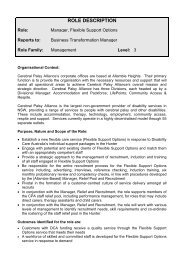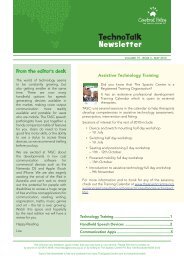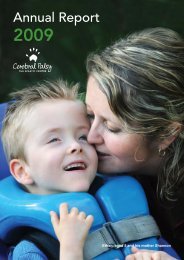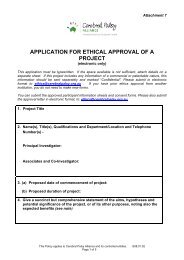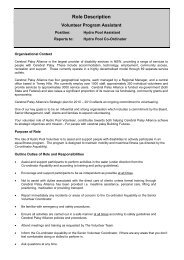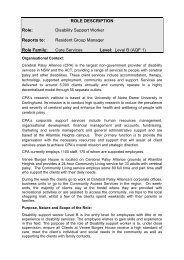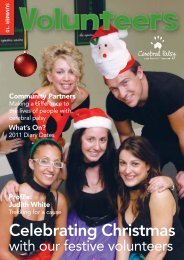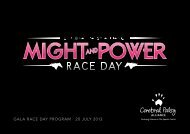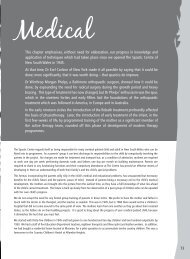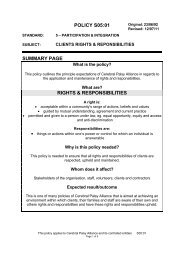Eye Tracking Technology - Cerebral Palsy Alliance
Eye Tracking Technology - Cerebral Palsy Alliance
Eye Tracking Technology - Cerebral Palsy Alliance
Create successful ePaper yourself
Turn your PDF publications into a flip-book with our unique Google optimized e-Paper software.
TECHNOTALKVOLUME 20 - ISSUE 1 - APRIL 2011ASSESSMENT CONSIDERATIONSAssessing a client’s ability to use eye tracking as an access method can be difficult, especially for a therapist who has limitedexperience in using an eye tracking system and/or limited experience in working with speech generating devices. There are manyconsiderations including clinical and technical issues that must be addressed in order to ensure that a valid and reliable assessmentof the client is able to be completed.For general information and assistance on the process to follow when completing an eye tracking assessment, please see the webbasedresource from the COGAIN website: http://www.cogain.org/w/images/5/5a/Assessment.pdfTASC can provide a handout to support therapists should some specific information on step-by-step considerations for what toconsider in an eye tracking assessment be required. A thorough eye tracking assessment is essential when applying for funding asclear assessment and clinical reasoning will be required in order for an eye tracking system to be funded.WHAT IS ACCURACY WHEN TALKING ABOUT EYE TRACKING?Generally, accuracy refers to the ability of the system to know where the eyes are actually looking. Accuracy of eyetracking may be affected by the quality of calibration, vision issues, eye variations, background/ambient lighting (especiallyincandescent bulbs and sunlight), head movement, the quality of the eye tracking system, and many other factors.The accuracy of a system when used by each client should be investigated and tested by the therapist during assessmentand trial of eye tracking systems. It should be noted that there are ways of compensating for poor accuracy onmost systems, so contact a specialist technology service or the supplier of the system. Also refer to the resources at:http://www.cogain.org/wiki/User_Involvement_Exemplars_GridsBACK-UP ACCESSAs with most technology, eye tracking is not completely reliable as an access method and there are environmental factors (especiallysunlight), and technological difficulties (software and hardware failure) that will mean that the user may not always be able toaccess their device or computer using their eye tracking system. TASC recommends that a back-up low-tech option is availablewhen eye tracking is used for the person to access communication and that an alternative computer access method is available forthose who use eye tracking to access a computer.LEARNING HOW TO USE EYE TRACKINGSome users of eye tracking systems who have no difficulties with calibration, cognitive abilities within normal limits and who canfollow complex instructions are able to learn to use eye tracking for basic access to a communication grid within a single therapysession, however for clients who have limited attention span, complex issues with their eyes, difficulty following instructions, and/or cognitive impairment, they may take much longer to learn how to use eye tracking or they may have difficulty learning to useeye tracking as a functional access method.This process of teaching a client how to use eye tracking may not be possible in trial circumstances as it may require the availabilityof an eye tracking system over a long period of time and the regular involvement of a therapist with experience in the teaching ofthe skill of eye tracking. Loans of eye tracking systems are usually limited to two or four weeks and for some users, this may not besufficient time to establish whether they have the capacity to use a system functionally.There is currently no research available regarding the age or level of cognition required to be able to functionally access eyetracking, however, TASC has experience in implementing eye tracking systems with clients as young as three years old who havebeen assessed as having a cognitive ability in the normal range.Once the functional skills and prerequisites for eye tracking have been established and clear goals have been set, the followingtable(s) can be used as a resource to match your client and their needs to the most suitable device. If you require support in thisfeature-matching process, it is recommended to consult with a specialist assistive technology service. Suppliers of eye trackingsystems may also be able to assist.CEREBRALPALSY.ORG.AU4



